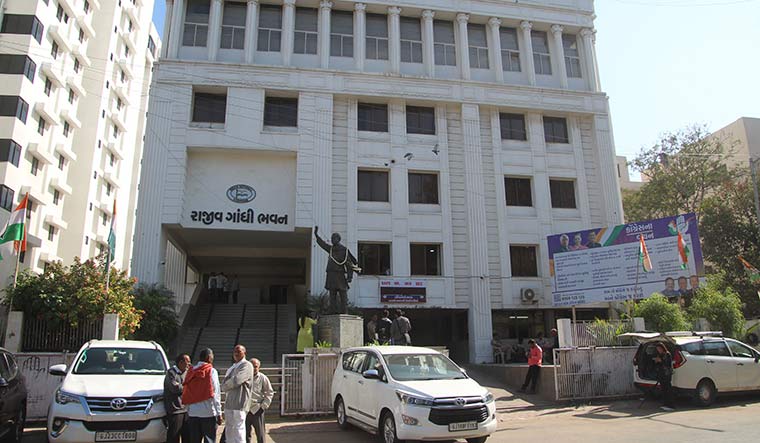THE CONGRESS HEADQUARTERS in Ahmedabad houses a paradox. It is December 5, and the second phase of polling is on. It is hard to miss the digital clock outside, counting down the days and time till the election results are out. “Time for change. Last few minutes for the BJP to be in power,” it reads. This bravado though is missing inside―there are no smiling faces among the few party leaders, workers and staff. For, instead of the clock, they seem to have seen the writing on the wall. Talk about wishful thinking vs reality check!
The Congress has been trying, rather unsuccessfully, to dislodge the BJP for more than two decades now. The closest it came to regaining power was in the 2017 polls―it won 77 of 182 seats as against the BJP’s 99. This time, it has won merely 17 seats.
The Aam Aadmi Party has clearly eaten into the Congress vote. As a senior Congress leader said, “The Congress should have woken up when the AAP won 27 seats in the Surat Municipal Corporation elections.” The Congress had drawn a blank in the civic polls.
Not that there were no issues plaguing the state that the Congress could have raised. Its only agitation to have an impact was the one against Tapi Par Narmada river-linking project, which was later cancelled. However, the credit for it goes to Vansda MLA Anant Patel, who has retained his seat.
Infighting apart, the Congress suffered from a lacklustre campaign. Post the Patidar quota stir in 2015, Congress leader Rahul Gandhi had campaigned aggressively in the 2017 polls. This time, he addressed only two public meetings. Moreover, his Bharat Jodo Yatra gave Gujarat a miss. The presence of Congress president Mallikarjun Kharge and Rajasthan Chief Minister Ashok Gehlot had little impact. In contrast, both the BJP and AAP had its top leadership addressing the most number of meetings and rallies.
Also read
- Gujarat: Modi mantra of good governance infused with hindutva pays rich dividends
- Modi magic dispels all obstacles to win Gujarat in style
- What can Congress learn from Gujarat loss and Himachal win
- In its local and state level endeavours, AAP aims to achieve its national ambition
- Himachal: 10 guarantees Congress gave to the voter that helped it win
- Exclusive: "We will bring honesty and transparency in Himachal Pradesh", says Sukhu
Said political analyst Achyut Yagnik, “The Congress does not have a leadership. Gone are the days when it had Madhavsinh Solanki and Jhinabhai Darji. Darji would have caste-wise equations of each district at his fingertips.” Darji was former state president and Solanki a former chief minister, under whom the party had won a record 149 seats in 1985.
However, the Congress’s vote share had continued to rise even after the electoral emergence of Modi in 2001, thanks to its committed voter base in rural areas, tribal belts, among dalits, Muslims and some of the other backward classes. Said political analyst Hemant Shah, “In 2017, the BJP’s vote share was 49.12 per cent and the Congress’s 41.42 per cent. It is a myth that the Congress isn’t doing anything.” There were 12 seats, scattered across Ahmedabad, north Gujarat and the tribal belt, that the Congress had not lost in the last two decades. Said Rajya Sabha MP Shaktisinh Gohil, “The Congress’s vote share had remained intact due to grassroots workers and their connect with the masses.”
The BJP, therefore, has lured into its fold a host of Congress leaders, including 17 MLAs, since 2017. Ahead of this elections, the Congress received a jolt as 11-time MLA Mohansinh Rathwa, tribal leader from Chhotaudepur, joined the BJP.


